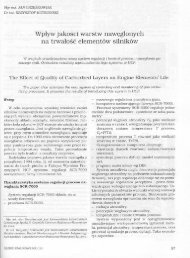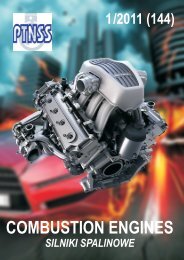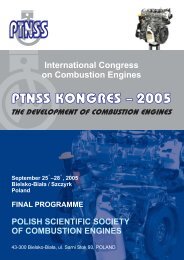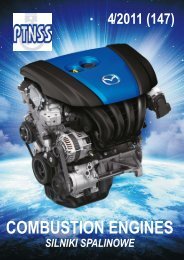You also want an ePaper? Increase the reach of your titles
YUMPU automatically turns print PDFs into web optimized ePapers that Google loves.
Wykorzystanie modeli wielorównaniowych do analizy procesów dynamicznych...<br />
N – number of measurements,<br />
n – number of input signals, m<br />
– number of output signals.<br />
3. The study of dynamic<br />
processes in the<br />
engine fuel supply<br />
system through multiequation<br />
models<br />
The object of this research<br />
was the engine fuel supply<br />
system (fuel injection) of a<br />
single-cylinder test engine<br />
1-SB installed in the Laboratory<br />
of the Operation of Marine<br />
Power Plants at the Polish<br />
Naval Academy (10). The<br />
experimental material was<br />
collected by a bivalent fractional<br />
plan. The implementation<br />
of specific measuring<br />
systems (measuring points)<br />
of the above experiment design<br />
was performed using a<br />
programmable controller that<br />
allowed a high repeatability<br />
of dynamic processes. The<br />
period between the onset of<br />
Variable/<br />
zmienna<br />
the clipping of the injection system components and the<br />
re-stabilization of the output quantities was adopted as the<br />
duration of the dynamic process. This period was selected<br />
through a series of experiments and it averaged to about<br />
320 s.<br />
Table 1. Least-squares estimation of the dependent variable y 1<br />
Tabela 1. Estymacja metodą najmniejszych kwadratów zmiennej zależnej y 1<br />
Coefficient/<br />
współczynnik<br />
Mean error/<br />
błąd stand.<br />
Student-t<br />
p value/<br />
wartość p<br />
i significance/<br />
istotność i<br />
y3_1 2.91309 1.43271 2.0333 0.04286 **<br />
x1_1 0.644317 0.130189 4.9491 < 0.00001 ***<br />
x3_1 –18.2606 5.31195 –3.4376 0.00067 ***<br />
y1_1 0.884015 0.0193211 45.7538 < 0.00001 ***<br />
Variable/<br />
zmienna<br />
Table 2. Least-squares estimation of the dependent variable y 2<br />
Tabela 2. Estymacja metodą najmniejszych kwadratów zmiennej zależnej y 2<br />
Coefficient/<br />
współczynnik<br />
Mean error/<br />
błąd stand.<br />
Student-t<br />
p value/<br />
wartość p<br />
i significance/<br />
istotność i<br />
y1_1 0.00120044 0.00067661 1.7742 0.07699 *<br />
x3_1 0.412034 0.0899356 4.5814 < 0.00001 ***<br />
y2_1 0.873606 0.0279092 31.3017 < 0.00001 ***<br />
Variable/<br />
zmienna<br />
Table 3. Least-squares estimation of the dependent variable y 3<br />
Tabela 3. Estymacja metodą najmniejszych kwadratów zmiennej zależnej y 3<br />
Coefficient/<br />
współczynnik<br />
Mean error/<br />
błąd stand.<br />
Student-t<br />
p value/<br />
wartość p<br />
i significance/<br />
istotność i<br />
y1_1 –5.65987e-05 2.41816e-05 –2.3406 0.01987 **<br />
x1_1 0.000396798 0.000206581 1.9208 0.05565 *<br />
y3_1 0.998597 0.00112836 884.9995 < 0.00001 ***<br />
reszty y 1<br />
= f(t) reszty y 2<br />
= f(t) reszty y 3<br />
= f(t)<br />
Fig. 2. Graph of the regression residuals for output variables where: y 1<br />
– concentration of carbon monoxide in the exhaust manifold C CO(k)<br />
[ppm];<br />
y 2<br />
– concentration of hydrocarbons in the exhaust manifold C HC(k)<br />
[ppm]; y 3<br />
– concentration of nitric oxides in the exhaust manifold C NOx(k)<br />
[ppm]; t –<br />
duration of the process [s]<br />
Rys. 2. Wykres reszt regresji dla zmiennych wyjściowych: y 1<br />
– stężenie tlenku węgla w kolektorze wylotowym spalin C CO(k)<br />
[ppm]; y 2<br />
– stężenie węglowodorów<br />
w kolektorze wylotowym spalin C HC(k)<br />
[ppm]; y 3<br />
– stężenie tlenków azotu w kolektorze wylotowym spalin C NOx(k)<br />
[ppm]; t – czas trwania<br />
procesu [s]<br />
In order to identify the impact of the technical condition<br />
of the fuel supply system on the parameters of the engine<br />
power during dynamic processes, sets of input quantities<br />
(preset parameters) and output quantities (observed parameters)<br />
were defined. For the purpose of this study a set of<br />
input quantities X was limited to three elements, that is:<br />
istotności parametrów modeli przedstawiono w tab. 1, 2,<br />
3. Największemu uproszczeniu uległy równania opisujące<br />
zmiany stężenia węglowodorów (y 2<br />
) oraz stężenia tlenków<br />
azotu (y 3<br />
) (tab. 2, 3). Dla równania opisującego zmiany<br />
węglowodorów, w sposób istotny zależą one od parametru<br />
struktury, który reprezentuje zakoksowanie otworów<br />
rozpylacza (x 3<br />
). Podobnie jest w odniesieniu do modelu<br />
opisującego zmiany stężenia tlenku węgla (y 1<br />
).<br />
O dobrym dopasowaniu modelu do wartości uzyskanych<br />
w wyniku eksperymentu na silniku może świadczyć<br />
równomierne rozłożenie reszt regresji od wartości średnich<br />
(rys. 2).<br />
84 <strong>COMBUSTION</strong> <strong>ENGINES</strong>, No. 4/2012 (151)












